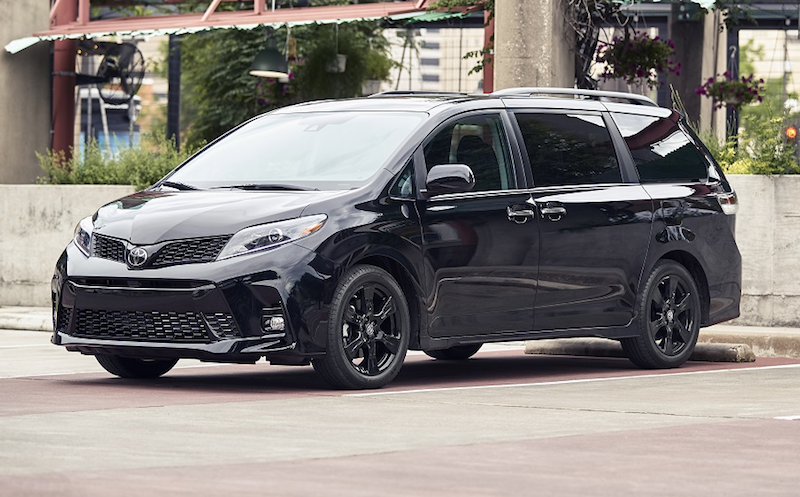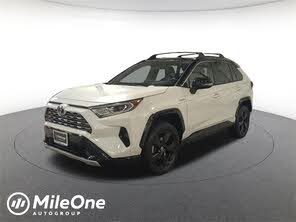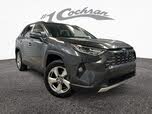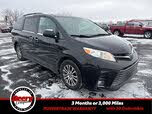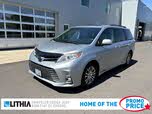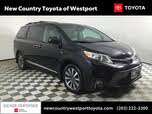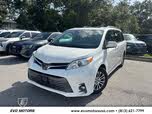2020 Toyota RAV4 Hybrid vs 2020 Toyota Sienna
Overview | |
MSRP$29,715 | MSRP$28,350 |
Listings411 | Listings578 |
Ratings & Reviews | |
User Reviews | User Reviews |
Expert reviews7.8 out of 10 | Expert reviews8.7 out of 10 |
Pros
Cons
| Pros
Cons
|
2020 Toyota Sienna Reviews SummarySince the second half of the 20th century, each decade has had a hot-topic family car, and, as we’ve noted in a number of reviews this year, the crossover is our current darling vehicle. Before the crossover, there were big, truck-based SUVs. Before that, there were station wagons. And for the past 35 years, there's always been the minivan. The Dodge Caravan has been widely considered the Patient Zero of the minivan segment. From there, seemingly everyone joined the party, including Toyota, Nissan, Ford, Chevy, GMC, Volkswagen, Oldsmobile, Ford, and more. Heck, even Mercury had a “Nautica Edition” version of the Villager. The minivan was king once, the crossover is king now, and some other type of vehicle will likely dominate in the near future. But in all this, the 7- and 8-passenger minivans will always represent the ultimate in versatility. The crossover is an image-forward fad with a dash of usability, but the minivan continues to prove itself as the pinnacle of practicality. The 2020 Toyota Sienna is neither the newest nor flashiest minivan out there, but when you absolutely need space for people and gear, there’s nothing better. Additionally, the Sienna is the only minivan to offer all-wheel drive (AWD), which is something specifically desired by many car buyers. | |
2020 Toyota RAV4 Hybrid Reviews SummaryThe RAV4 Hybrid offers a nearly perfect package of compact crossover attributes: Standard all-wheel drive, a roomy passenger compartment, and excellent fuel economy. It’s a pretty good value, too, with pricing starting at $29,470, which includes plenty of standard multimedia and safety features. It’s no wonder sales of the hybrid version of Toyota’s bestseller almost doubled in 2019. | |
No video found | |
Popular Features & Specs | |
Engine3.5L 296 hp V6 | Engine2.5L 219 hp I4 Hybrid |
Drive TrainFWD | Drive TrainAWD |
Seating Capacity2 | Seating Capacity5 |
Horsepower296 hp @ 6200 rpm | Horsepower |
EV Battery Capacity | EV Battery Capacity1.6 kWh |
MPG City19 | MPG City41 |
MPG Highway26 | MPG Highway38 |
Engine | |
Engine Name3.5L 296 hp V6 | Engine Name2.5L 219 hp I4 Hybrid |
Torque263 lb-ft @ 4700 rpm | Torque |
Horsepower296 hp @ 6200 rpm | Horsepower |
DrivetrainFWD | DrivetrainAWD |
Fuel Economy | |
EV Battery Capacity | EV Battery Capacity1.6 kWh |
MPG City19 | MPG City41 |
MPG Highway26 | MPG Highway38 |
Interior | |
Seating Capacity2 | Seating Capacity5 |
Safety | |
Front Crash Overall4 | Front Crash Overall4 |
Side Crash Overall5 | Side Crash Overall5 |
Dimensions & Capacity | |
Cargo Space | Cargo Space37.6 cu ft |
Curb Weight4375 lbs | Curb Weight3710 lbs |
Height68.9 in | Height67.0 in |
Length200.2 in | Length180.9 in |
Width78.1 in | Width73.0 in |
Wheelbase119.3 in | Wheelbase105.9 in |
Maximum Payload | Maximum Payload1210 lbs |
Number of doors4 | Number of doors4 |
Maximum Towing Capacity | Maximum Towing Capacity1750 lbs |
Overview | ||
MSRP | $29,715 | $28,350 |
Listings | ||
Ratings & Reviews | ||
User reviews | ||
Expert reviews | 7.8 out of 10Read full review | 8.7 out of 10Read full review |
Pros & cons | Pros
Cons
| Pros
Cons
|
Summary | Since the second half of the 20th century, each decade has had a hot-topic family car, and, as we’ve noted in a number of reviews this year, the crossover is our current darling vehicle. Before the crossover, there were big, truck-based SUVs. Before that, there were station wagons. And for the past 35 years, there's always been the minivan. The Dodge Caravan has been widely considered the Patient Zero of the minivan segment. From there, seemingly everyone joined the party, including Toyota, Nissan, Ford, Chevy, GMC, Volkswagen, Oldsmobile, Ford, and more. Heck, even Mercury had a “Nautica Edition” version of the Villager. The minivan was king once, the crossover is king now, and some other type of vehicle will likely dominate in the near future. But in all this, the 7- and 8-passenger minivans will always represent the ultimate in versatility. The crossover is an image-forward fad with a dash of usability, but the minivan continues to prove itself as the pinnacle of practicality. The 2020 Toyota Sienna is neither the newest nor flashiest minivan out there, but when you absolutely need space for people and gear, there’s nothing better. Additionally, the Sienna is the only minivan to offer all-wheel drive (AWD), which is something specifically desired by many car buyers. | The RAV4 Hybrid offers a nearly perfect package of compact crossover attributes: Standard all-wheel drive, a roomy passenger compartment, and excellent fuel economy. It’s a pretty good value, too, with pricing starting at $29,470, which includes plenty of standard multimedia and safety features. It’s no wonder sales of the hybrid version of Toyota’s bestseller almost doubled in 2019. |
Video | No video found | |
Popular Features & Specs | ||
Engine | 3.5L 296 hp V6 | 2.5L 219 hp I4 Hybrid |
Drive Train | FWD | AWD |
Seating Capacity | 2 | 5 |
Horsepower | 296 hp @ 6200 rpm | |
EV Battery Capacity | 1.6 kWh | |
MPG City | 19 | 41 |
MPG Highway | 26 | 38 |
Engine | ||
Engine Name | 3.5L 296 hp V6 | 2.5L 219 hp I4 Hybrid |
Torque | 263 lb-ft @ 4700 rpm | |
Horsepower | 296 hp @ 6200 rpm | |
Drivetrain | FWD | AWD |
Fuel Economy | ||
EV Battery Capacity | 1.6 kWh | |
MPG City | 19 | 41 |
MPG Highway | 26 | 38 |
Interior | ||
Seating Capacity | 2 | 5 |
Safety | ||
Front Crash Overall | 4 | 4 |
Side Crash Overall | 5 | 5 |
Dimensions & Capacity | ||
Cargo Space | 37.6 cu ft | |
Curb Weight | 4375 lbs | 3710 lbs |
Height | 68.9 in | 67.0 in |
Length | 200.2 in | 180.9 in |
Width | 78.1 in | 73.0 in |
Wheelbase | 119.3 in | 105.9 in |
Maximum Payload | 1210 lbs | |
Number of doors | 4 | 4 |
Maximum Towing Capacity | 1750 lbs | |
The 2020 Toyota Sienna, part of its third generation, had been around since the 2011 model year. Despite a 2018 update that introduced newer infotainment tech and minor changes, the 2020 Sienna still felt dated. The front doors emitted a hollow "thud" when slammed, indicating a lack of attention to fit and finish. The instrument panel, reminiscent of Toyota's 2010 parts bin, was simple but easy to use. The Sienna offered various trims, from the base L with 17-inch alloy wheels and a 7-inch touchscreen with Apple CarPlay, to the Limited Premium with leather seats, a JBL premium audio system, and a DVD entertainment system. The SE trim, recommended by CarGurus, featured 19-inch alloy wheels, a mesh grille, and a power rear liftgate, making it a practical choice for families.
The 2020 Toyota RAV4 Hybrid, redesigned in 2019, sported a tougher, more angular look, reminiscent of the 4Runner. Its front fascia, with stacked trapezoidal apertures and a perforated grille, gave it a mechanical appearance. Dark trim around the wheel wells and doorsills hinted at its off-road capabilities. Available in four trims—LE, XLE, XSE, and Limited—the RAV4 Hybrid featured 17-inch wheels on lower trims and 18-inch wheels on higher trims. LED headlights and taillights were standard, with adaptive headlights available on the top trim. Inside, the RAV4 Hybrid's design was simple and functional, with tasteful trim and comfortable fabric seats. The interior materials were nice, though not as luxurious as some competitors like the Honda CR-V Hybrid.


















The 2020 Toyota Sienna came equipped with a 3.5-liter V6 engine, producing 296 horsepower and 263 pound-feet of torque, paired with an 8-speed automatic transmission. The Sienna offered stout acceleration in normal Drive mode, with a Sport mode for livelier throttle and shift response. It also had a manual mode, useful for its 3,500-pound towing capacity. The Sienna's power was routed to the front wheels, with an AWD option available for all trims except the base L. The FWD Sienna returned 19 mpg city, 26 highway, and 21 combined, while AWD versions returned 18/24/20. The Sienna's low center of gravity and broad base contributed to surprisingly decent handling dynamics, though its twitchy steering response at higher speeds required constant attention.
The 2020 Toyota RAV4 Hybrid boasted 219 horsepower, 16 more than the standard version, with a combined EPA fuel economy rating of 40 mpg. The RAV4 Hybrid's powertrain combined a 2.5-liter, 176-horsepower four-cylinder gasoline engine with two electric motors, driving all four wheels. The first electric motor delivered up to 118 hp to the front wheels, while the second motor, mounted under the cargo floor, provided 54 hp to the rear wheels. The RAV4 Hybrid's nickel-metal hydride battery, located under the rear seats, powered both electric motors. The hybrid system provided plenty of instantaneous electric power, making the RAV4 Hybrid quicker to accelerate than the non-hybrid model. It also offered smooth regenerative braking and a towing capacity of up to 1,750 pounds.
The 2020 Toyota Sienna excelled in cargo space, offering 150 cubic feet, more than competitors like the Chrysler Pacifica and Honda Odyssey. However, accessing this space required removing the second-row seats, which could be cumbersome with the second-row bench. The third row folded seamlessly into the floor, but getting into the backseat was challenging. Toyota also offered mobility access features, such as the Auto Access Seat, making the Sienna a practical choice for those needing mobility conversions.
The 2020 Toyota RAV4 Hybrid featured excellent ergonomics, with a standard 7-inch touchscreen (an optional 8-inch screen) positioned prominently atop the center dashboard. The center console provided ample storage, including a space for a cell phone, two cupholders, and a large storage bin under the armrest. The RAV4 Hybrid's cabin could be quieter, but it remained comfortable on long trips. The rear seat offered impressive legroom, accommodating three adults comfortably. The hybrid model did not compromise interior or cargo space, maintaining the same 98.9 cubic feet of passenger volume and 37.6 cubic feet of trunk capacity as the standard RAV4.
The 2020 Toyota Sienna's base L trim came with a 7-inch touchscreen infotainment system, supporting Amazon Alexa and Apple CarPlay. Other standard tech features included Bluetooth connectivity, five USB ports, and a WiFi hotspot with a 6-month trial. Higher trims, like the Limited, added navigation and a JBL 10-speaker premium audio system. The Sienna also featured Driver Easy Speak, an intercom system that broadcasted the driver's voice to the rear speakers, making it easier to communicate with passengers in the back.
The 2020 Toyota RAV4 Hybrid introduced Android Auto for the first time, joining Apple CarPlay and SiriusXM Radio as standard features. The RAV4 Hybrid's infotainment system, with a USB-A port on the dash, was user-friendly, though it lacked USB-C ports. Higher trims included additional USB-A charging ports and an optional Qi wireless charging tray. The RAV4 Hybrid also featured Predictive Efficient Drive, which optimized battery usage based on driver inputs and navigation data. Drivers could select different drive modes, including Eco, Sport, and Trail, to suit their preferences.
The 2020 Toyota Sienna came standard with Toyota Safety Sense (TSS-P), which included lane-departure warning, lane-keep assist, forward-collision warning with pedestrian detection, dynamic cruise control, and automatic high beams. Blind-spot monitoring was optional on lower trims and standard on XLE and Limited trims. The Sienna earned five stars in NHTSA crash testing and received top scores from the IIHS in several areas, including side crash and rollover crash.
The 2020 Toyota RAV4 Hybrid featured Toyota Safety Sense 2.0 as standard, including a pre-collision system with automatic emergency braking, full-speed range dynamic radar adaptive cruise control, lane-departure alert with steering assist, automatic high beams, lane-tracing assist, and road-sign assist. The RAV4 Hybrid also included a 1-year trial of Safety Connect. Optional safety features included blind-spot monitoring and front and rear parking assist with automated braking. The RAV4 Hybrid received a five-star rating from NHTSA and a Top Safety Pick designation from the IIHS for the standard RAV4.
CarGurus highlights

According to CarGurus experts, the overall rating for the 2020 Toyota Sienna is 7.8 out of 10, while the 2020 Toyota RAV4 Hybrid scores 8.7 out of 10. Based on these ratings, the 2020 Toyota RAV4 Hybrid is the recommended choice, offering superior fuel efficiency, advanced safety features, and a more modern design.
Choose the 2020 Toyota RAV4 Hybrid if:
- You prioritize fuel efficiency, with a combined EPA rating of 40 mpg.
- You want a hybrid SUV with no compromise on interior or cargo space.
- You seek a vehicle with advanced safety features and excellent crash test ratings.
Choose the 2020 Toyota Sienna if:
- You need maximum cargo space and are willing to remove the second-row seats to access it.
- You require mobility access features, such as the Auto Access Seat.
- You prefer a minivan with a variety of trims and features to suit different needs.
CarGurus highlights

According to CarGurus experts, the overall rating for the 2020 Toyota Sienna is 7.8 out of 10, while the 2020 Toyota RAV4 Hybrid scores 8.7 out of 10. Based on these ratings, the 2020 Toyota RAV4 Hybrid is the recommended choice, offering superior fuel efficiency, advanced safety features, and a more modern design.
Choose the 2020 Toyota RAV4 Hybrid if:
Shop Now- You prioritize fuel efficiency, with a combined EPA rating of 40 mpg.
- You want a hybrid SUV with no compromise on interior or cargo space.
- You seek a vehicle with advanced safety features and excellent crash test ratings.
Choose the 2020 Toyota Sienna if:
Shop Now- You need maximum cargo space and are willing to remove the second-row seats to access it.
- You require mobility access features, such as the Auto Access Seat.
- You prefer a minivan with a variety of trims and features to suit different needs.

By: CarGurus + AI
At CarGurus, our team of experienced automotive writers remain at the heart of our content operation, conducting hands-on car tests and writing insightful guides that are backed by years of industry experience. To complement this, we are harnessing AI to make our content offering more diverse and more helpful to shoppers than ever. To achieve this, our AI systems are based exclusively on CarGurus content, ratings and data, so that what we produce is both unique to CarGurus, and uniquely helpful to car shoppers.
